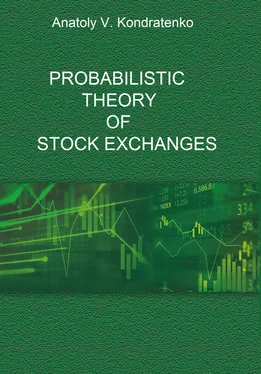1 ...6 7 8 10 11 12 ...15 1.5.2. AGENT PRINCIPLE
This is generally the most important concept, or paradigm, in respect of the markets. Here it is: every market consists of market agents, buyers and sellers, interacting quite intensively, and prone not only to competition, but also to mutually beneficial social cooperation. There are no other market forces in markets, except the forces of market agents’ interaction. All market results are a consequence of the market agents’ actions, even if their actions were strongly influenced by other factors: the state, institutions, etc. Everything that happens in markets is done by interacting market agents and therefore only agent-based models (agent action-based models or below simply action-based models) can provide a reasonable and reliable quantitative basis for any modern economic theory. And the actions of market agents in the market are exactly the issuing of bids or quotations to buy or sell, which was discussed above.
1.5.3. INSTITUTIONAL AND ENVIRONMENTAL PRINCIPLE
Markets are never completely closed or free. All market agents are constantly influenced not only by other agents, but also by numerous external forces and factors. These external forces and factors, playing the role of boundary conditions, give economic systems harmony, integrity and stability. The most important of these are, of course, institutions of various kinds, such as the state, trade unions, laws, innovations, etc. Just as important might be such forces and factors of the external environment as other markets and economies, including foreign ones, as well as natural and man-made processes, etc. The influences exerted by each of these forces and factors on the structure of market prices and on market behavior can be comparable to the effect of the market agents’ interaction. Moreover, the actions of strong external institutional and environmental factors can significantly both stimulate and impede effective operation of internal market mechanisms and even partially suppress effective functioning of the market as a whole. Thus, the influence of institutional and environmental factors should be adequately taken into account in models together with interaction between market agents.
1.5.4. DYNAMIC AND EVOLUTIONARY PRINCIPLE
Modern markets are complex non-linear nonequilibrium dynamic systems, since all market agents are in constant interaction with each other and external forces, in other words, in constant motion in search of profitable connections to buy or sell goods and services. Buyers seek to buy as low as possible, and sellers want the highest possible price. Mathematically, we can describe this time-dependent dynamic and evolutionary market process as a movement in some formal economic space of market agents acting according to objective economic laws. Therefore, this movement has a somewhat deterministic character, and the market movement itself, or the evolution of the market system, in time can be approximated by equations of motion similar to the equations of motion in physics, such as the Lagrange equations in classical mechanics or Schrödinger equations in quantum mechanics.
1.5.5. TRADE VOLUME MAXIMIZATION PRINCIPLE
In relatively free markets, buyers and sellers consciously and deliberately enter into trade deals with each other, because they enter into transactions only on mutually beneficial terms. It is not necessarily the case that they will seek to maximize their profits in every deal they make, since they understand that deals can only be mutually beneficial. But they try, usually, to increase their financial benefit by entering into as many of these mutually beneficial transactions as possible. Thus, it can be argued that the market as a whole seeks to maximize the trade volume, and moreover, to do it in monetary terms, as agents naturally seek, in the end, to increase their personal profits expressed in terms of money. This principle triggers the market process and the action of the laws of supply and demand. But the role of the state should also be taken into account, since it is present in the market as a full-fledged market agent and because, due to its enormous resources, it can, figuratively speaking, play not only the part of the first violin, but also the role of the conductor in this orchestra. Consequently, market dynamics can be approximated by applying the trade volume maximization principle to the market as a whole. Due to the fact that at present we do not have a developed mathematical body to use the more general principle of least action and the corresponding Lagrange equations of motion, the trade volume maximization still remains the only tool in this theory that helps to evaluate at least short-term trends in market dynamics.
1.5.6. UNCERTAINTY AND PROBABILITY PRINCIPLE
Uncertainty and probability always accompany human action in the markets, therefore without taking them into account it is impossible to operate successfully for a sufficiently long period of time. This is caused by the very nature of human reasoning and the fundamental human inability to accurately predict the future state of markets. Moreover, according to the institutional and environmental principle, markets are constantly under the influence of various institutions and environmental factors. For these reasons, all market agent decisions and actions, and hence all market processes and phenomena, are essentially probabilistic, so they can only be adequately described by applying probabilistic mathematical methods and models. On the same grounds, demand and supply functions should also be described in terms of probability distributions.
To introduce some certainty, let us note that the first five principles, along with the axiom, constitute the basis for building a market model in which probabilistic effects are absent or not explicitly considered. We will call such a model classical because of its certain similarity to concepts of both classical economic theory and classical mechanics. Adding the sixth principle (the uncertainty and probability principle) to this base provides a basis for building a full-fledged probabilistic theory, which is naturally broader in nature and has much greater opportunities for further development. Obviously, from the methodological point of view, the classical model can be considered as a fairly good initial approximation of the probabilistic theory, which makes it possible to quantify the probabilistic effects by comparing the results of classical and probabilistic calculations. As a matter of fact, this exact possibility is the justification for building and using the classical model.
We believe that these six general principles can serve as a good basis to describe fully and adequately enough the main structural and dynamic properties of market economic systems and market processes in them. These principles and their rationale will be further discussed in more detail on several occasions. And the accuracy of the probabilistic economics built in this way and the limits of its applicability should and will, naturally, be determined in this study by comparing the results of calculations carried out using the numerical methods of this theory with the corresponding experimental data.
And now we will make three principal assertions, the validity of which is practically obvious from the very method of building a probabilistic economics.
Statement 1.Probabilistic economics can be regarded as a kind of unified economic theory focused primarily on the quantitative description of organized markets. Indeed, this theory is based on principles which are, to a certain extent, similar to concepts borrowed from various economic theories. For example, the fundamental concept of neoclassical theory, namely the concept of supply and demand, is also used as a basis for probabilistic economics. The concept of the market process and the subjectivist principle of value is borrowed from the Austrian school of economics; the institutional principle from institutional economics [Hodgson, 1988]; the position on the continuous evolution of economic systems from evolutionary economics [Nelson, Winter, 1982], etc. The mathematical body of probabilistic economics, organized similar to the methods of theoretical physics of multiparticle systems, allows to include these well-known achievements of economic thought into this probabilistic theory in a harmonious and clear way. To be fair, it should be said that all the principles of probabilistic economics follow as a necessity both from the method of theory construction itself and from the attempt to create adequate equations of motion for action-based models of economic systems by analogy with the equations of motion for physical multiparticle systems. This is how these principles were first derived and formulated [Kondratenko, 2005, 2015]. Moreover, it is obvious that these principles, as well as the axiom of the theory, are formulated intentionally in a rather general way, which emphasizes the fact that they are not absolute and can and obviously will be changed and refined as the theory develops and its possibilities and applications Expand. Just as it happens during creation of any physical theory, a creation focused on continuous verification of the theory by comparing the calculations results with experimental data, if, of course, such experiments have been performed and their results are known, otherwise, the authors of the theory try to suggest such experiments..
Читать дальше












